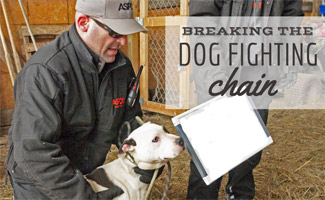Dog Fighting Facts: We Need To Break The Chain
When you purchase through links on our site, we may earn a commission. Here’s how it works.

Many people see dogfighting as a relic of our distant past or a sick phenomenon that ended the day Michael Vick was arrested eighteen years ago. Even if it exists, surely it occurs only in a handful of dark corners of our country, run by individuals too despicable to live as ordinary members of our communities, right?
Table of Contents
Sadly, none of those statements are true. In a poll the ASPCA released in April 2018 for Prevention of Cruelty to Animals Month, it was found that there are widespread misperceptions about the prevalence of dogfighting, where it happens, and the types of people committing these crimes. The study also found misunderstandings about the signs of dogfighting and even an unwillingness to report suspected dogfighting activity.
For the sake of thousands of animals being tortured and victimized every year, it’s time for a reality check.
The Truth About Dogfighting
In our poll, 57 percent of the respondents believed dogfighting never happens in their community. But dogfighting occurs more often and in more places than most people think and is more horrific than most can imagine.
I spent years overseeing and deploying with our ASPCA Anti-Cruelty teams, but I am still horrified at stories of animals routinely and viciously attacked, beaten, electrocuted, and drowned. I’m also repulsed by the use of “rape stands” for breeding and “bait dogs” for fighting practice.
Fighting dogs are typically raised in isolation, spending most of their lives on short, heavy chains. They are regularly conditioned with drugs, including anabolic steroids, to enhance muscle mass and encourage aggressiveness. During fights, these animals suffer puncture wounds, blood loss, crushing injuries, and broken bones. Many eventually succumb to their injuries, and losing dogs are often discarded, killed, or brutally executed.
How Common Is Dog Fighting?
These fights can happen anywhere, from farms in Alabama to basements in New York City. Since 2009, the ASPCA has assisted with over 300 dogfighting cases in more than 24 states, assisting nearly 6,000 victims of dog fighting. Last year alone, the ASPCA directly rescued more than 400 animals from dogfighting across 12 states.
We estimate that people who fight dogs number in the tens of thousands, forcing hundreds of thousands of dogs to train, fight, and suffer every year. Dogfights are also connected to gambling, illegal drug and firearm sales, and other crimes.
Dog fighting fact: It is estimated that over 40,000 people participate in dogfighting every year, putting close to 250,000 dogs into the fighting pit. Along with the ASPCA, the National Humane Society rescues hundreds of dogs every year from horrible dogfighting situations.
And contrary to stereotypes, dogfighters are often the kinds of people we interact with all the time, including lawyers, teachers, high school football coaches, nurses, veterinary technicians, and judges, spanning all racial and socioeconomic lines. There is no “typical” dogfighter; the only qualities they share are callous greed and sadism.
Recognizing And Responding To Dogfighting
Fewer than a third of poll participants reported being very confident they would recognize the signs of dogfighting, so let’s be clear about what to look for. Signs of dogfighting include dogs with multiple scars, possibly with lips or ears ripped off. Dogs are often kept on heavy chains, tethered to tire axles or dog houses, with a dirt ring around the dog. Dogs are chained inches apart from one another, with dogs chained or penned in a secluded area intentionally kept out of the public’s view.
When you do suspect dogfighting, what is your first instinct? Contact a shelter or local animal control agency. Post a question or thought online? Bury your head? In our poll, only about half of respondents who’ve suspected dogfighting did the right thing: Call the police. Twenty-five percent did nothing at all.
There are anti-cruelty laws on the books, and it’s the police’s job to enforce them. These calls can even be made anonymously. Offenders face hefty fines and jail time.
What You Should Do
If you have or know a dog, you understand that dogfighting is the ultimate betrayal – taking that natural love and loyalty and twisting it to profit from their misery. Some dogs are fostered, recover and lead happy, comfortable lives. Others are not so fortunate, especially those breeds thought to be aggressive or likely to bite.
These animals need rescue but deserve protection, which means stopping dogfights before they start. National Dogfighting Awareness Day, April 8, is our annual effort to counter destructive misperceptions with truth, promote lifesaving awareness, and encourage reporting to the police. This will not only save lives but reinforce compassion as a driving force and strongly-held value in our culture.
Of course, especially if you’re reading this, you may not know about a dogfight personally. But somewhere in your community – whether actual or online – someone likely knows someone who does and may even be involved. Dog fighting rings exist in both big cities and rural areas, and big money is involved. Bets can reach $100,000 for a single fight. So, this year, educate yourself as a first step in educating others.
Is Dog Fighting Legal?
Legally, dogfighting is a crime in every state, but it will take communities acting proactively and with determination to break those chains for good.
Video: Dog Fighting
Watch this three-minute video as Matt talks with Senior Director of Planning and Field Operations Joel Lopez about the prevalence of dogfighting.
This guest post is written by Matt Bershadker, President and CEO of the American Society for the Prevention of Cruelty to Animals (ASPCA). Read another post by Matt about the ASPCA’s behavioral rehab center.



